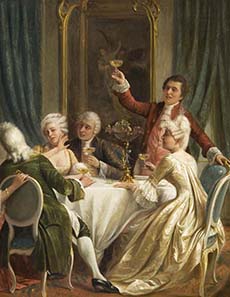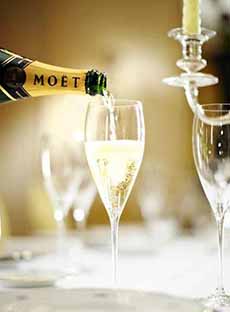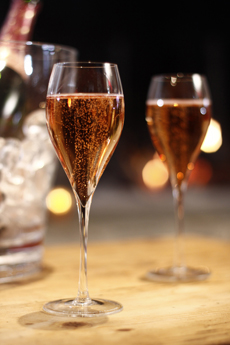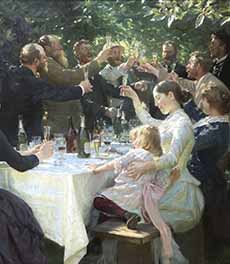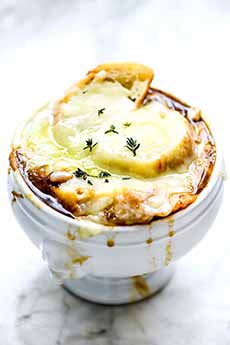FOOD HISTORY: The History Of Toasting To Your Health
|
Do you toast to the New Year? If you’ve wondered how the practice originated: It began in pre-history and evolved over the millennia. And for many centuries, a piece of toast was floated in the punch bowl. The scoop: The practice of toasting to someone’s health goes back to ancient times. Evidence reveals that most ancient societies raised a glass. Drinking to health continued over the centuries. But the term “toast” did not originate until the 16th century, and it did involve a piece of toast. One of the first written accounts appears in Shakespeare’s The Merry Wives Of Windsor when the character of Falstaff demands of Bardolf, a rogue member of his posse: “Go fetch me a quart of sack; put a toast in’t.” Adding toast to wine was actually quite a common practice in that period—and long before. The term “wassail” (WASS-ul) was a greeting among Anglo-Saxons, who inhabited England beginning in the 5th century. These Germanic tribes migrated from continental Europe, and their language was what is now known as Old English. “Wassail” is Middle English contraction of “wæs hæil,” a toast meaning “good health” or “be healthy.” The wassail tradition began in pre-Christian times, in southern England. The region’s apple groves produced a major food crop, from which [alcoholic] cider was made. The early tradition of “wassailing” was a festive procession of townspeople into apple groves, with songs or chants, and the sharing of alcohol from jugs. Participants tied pieces of toast to apple tree branches, meant to ensure a good crop. By the 14th century, in Merrie Olde England, wassail referred to a holiday punch bowl and the mulled beverage inside of it. Beer, cider, mead, and later, wine were heated with spices (mulled) and topped with a slice of toast. Every good Christmas gathering included a wassail bowl, and people toasted as they drank their “cup of good cheer.” They held high, and often clinked, their glasses (more about that below). Bowls of hot mulled cider were served in homes to visitors, and the custom of caroling (a.k.a. wassailing) led groups to go from door to door, singing for a drink. (The custom of singing Christmas carols, charming in recent centuries may well have begun as a way to get free drinks.) The terms “toast” and “toasting” emerged to describe both drinking to one’s health and drinking to honor a person or occasion, at any time of year. For another couple of centuries, there was still a piece of toast involved, added to the top of the jug or pitcher. The piece of toast might be presented to the honoree. Saturated through with wine, it was tasty—and added to the alcohol content consumed. The piece of toast gradually disappeared, and in the 17th century the position of toastmaster emerged. His job was to ensure that the toasting didn’t become too excessive and that everyone got his opportunity to toast the honoree: One historian notes: Toasting was a great excuse to drink a large amount of alcohol without being seen as a staggering drunk. So if left to their own devices, participants would toast every individual in the room [source]. |
|
|
|
TOASTING GAMES & PRACTICES In Shakespeare’s time, drinking games became customary. There was a particularly unusual practice where a gentleman would cut himself, mix his blood into his drink and toast to his lady love as another way to prove his devotion. A particularly beautiful lady was “the toast of the town.” But toasting was often rowdy. To orient toasting toward civilized behavior, “Toastmaster” books were published to teach the refined toasting etiquette. Some contained a selection of toasting phrases—since even centuries ago, people had trouble creating one.
In terms of why we clink glasses and say “cheers,” there are at least four non-related explanations: By the 18th century, it meant “gladness.” The practice endured: We still wish our fellow partiers gladness, or happiness. “Here’s to a bright New Year and a fond farewell to the old; here’s to the things that are yet to come, and to the memories that we hold.” |
||
